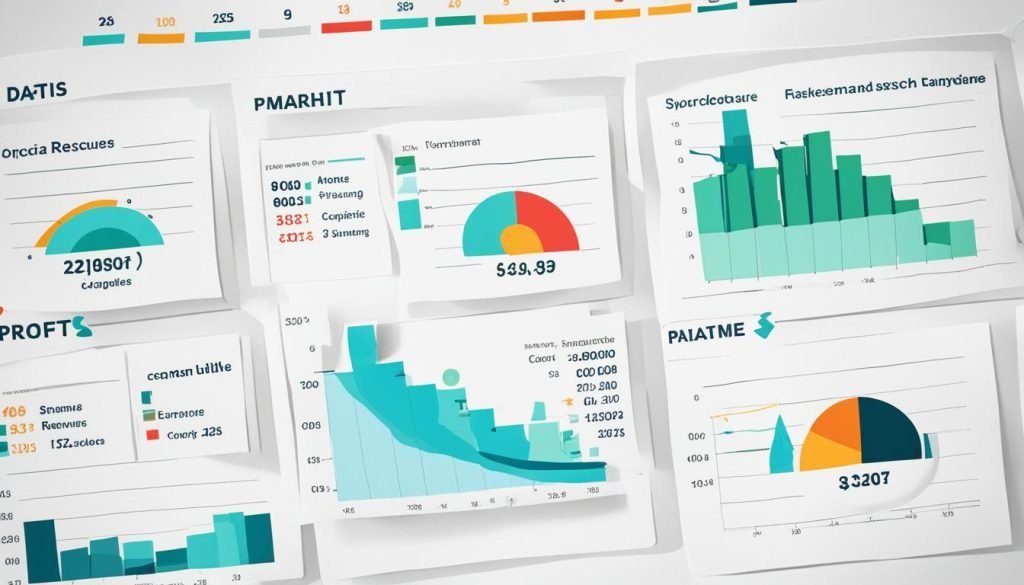Quarterly earnings reports are key for investors to check on a company’s financial health. They give a deep look at how well a company is doing with its money. By looking at these reports, investors can make smart choices about where to put their money.
Some reports show great numbers, but it’s important to know the difference between what’s shown and what’s real. Companies must send a Form 10-Q to the SEC. This includes financial statements, risk info, and talks from management. Getting the hang of these reports helps investors make better choices.
Key Takeaways
- Quarterly earnings reports are essential for evaluating financial performance.
- Investors should differentiate between optimistic presentations and actual performance.
- Form 10-Q is a mandatory filing with vital financial data.
- Understanding these reports enhances informed investor decision-making.
- Financial statements provide insights into a company’s overall health.
Understanding Quarterly Earnings Reports
Quarterly earnings reports are key for investors. They show a company’s financial health over a set period. These reports cover revenue, expenses, net income, and earnings per share (EPS). Investors use this info to make smart choices about their investments.
The Importance of Earnings Reports for Investors
Earnings reports let investors peek into a company’s health. They show trends in making money, being efficient, and financial stability. When a company shares its earnings, it can make investors feel hopeful or worried.
This affects how they plan their investments. It helps set realistic goals and strategies.
How Earnings Reports Affect Stock Prices
Earnings reports often come with big changes in stock prices. A good report can make stocks go up as investors buy more. But a bad report can cause prices to drop as investors sell.
| Company | Q1 Earnings | Q2 Earnings | Stock Price Change |
|---|---|---|---|
| Company A | $10 million | $15 million | +20% |
| Company B | $8 million | $6 million | -10% |
| Company C | $12 million | $18 million | +15% |
Components of Company Earnings Reports
It’s key to know the parts of company earnings reports for a full financial check-up. These reports have three main parts: the income statement, balance sheet, and cash flow statements. Each is vital for understanding a company’s financial health.
Income Statement Breakdown
The income statement gives a detailed look at a company’s earnings and spending over time. It shows important numbers like gross profit, operating income, and net income. By looking at this, investors can see how profitable a company is and spot trends that might affect future earnings.
Overview of Balance Sheet Information
A balance sheet shows a company’s financial state at a certain point. It lists assets, liabilities, and equity, giving a full financial view. If assets and equity are more than liabilities, the company looks financially stable. This is important for investors thinking about potential returns.
Cash Flow Statements Explained
Cash flow statements show how cash moves in and out during the period. They split cash flow into operating, investing, and financing activities. Knowing these helps investors see a company’s cash situation and how well it runs, making cash flow statements key for good decisions.

Analyzing Revenue Disclosures and Profit Margins
Revenue disclosures and profit margins are key for investors. They show how well a company does and its market strength. Looking closely at these numbers helps understand a business’s health.
What to Look for in Revenue Disclosures
Investors should look at a few things in revenue disclosures:
- Year-over-Year Growth Rates: This shows if the company is growing or shrinking.
- Revenue Sources: Knowing where the money comes from helps spot risks or chances for growth.
- Geographical Performance: Seeing how different areas do can tell us about market reach and growth.
Understanding and Evaluating Profit Margins
Profit margins tell us how well a company controls its costs. Investors should watch these closely:
- Gross Profit Margin: This is what’s left after selling costs are taken out. It shows how well production costs are managed.
- Net Profit Margin: This is the profit left after all costs, showing the company’s true profit level.
- Industry Comparisons: Seeing how a company stacks up against others in the industry shows its competitive edge.
When revenue or profit margins don’t look right, it might mean problems or challenges. Investors should dive deep into the numbers to understand these issues.

| Company | Gross Profit Margin (%) | Net Profit Margin (%) | Year-over-Year Revenue Growth (%) |
|---|---|---|---|
| Company A | 45% | 20% | 10% |
| Company B | 38% | 15% | 5% |
| Company C | 50% | 25% | 12% |
Insights from Earnings Calls and Wall Street Guidance
Earnings calls are key for investors. They let company leaders share insights on how the company is doing and its plans. These calls add depth to the numbers in earnings reports. They help investors understand management’s view on the company’s future.
The Role of Earnings Calls in Investor Decision-Making
Executives talk about more than just numbers during earnings calls. They share details that could affect the future. Investors should pay attention to the tone and words used. A positive tone can mean confidence, while cautionary words might hint at upcoming issues.
How Wall Street Guidance Influences Market Expectations
Wall Street guidance is key before earnings announcements. Analysts’ predictions set the stage for what investors expect. When actual results come out, it can change stock prices. Knowing this helps investors predict how the market might react.
| Guidance Type | Impact on Market | Investor Action |
|---|---|---|
| Positive Guidance | Generally leads to stock price increases | Consider buying or holding shares |
| Negative Guidance | Often results in stock price declines | May prompt selling or shorting the stock |
| No Change in Guidance | Neutral impact; slight fluctuations possible | Assess business fundamentals and performance |
Preparing for Earnings Reports: What Investors Should Know
Getting ready for earnings reports is key to making smart investment choices. Investors should pay attention to important metrics and know what analysts expect. This knowledge is crucial for making the most of earnings report preparation.
Key Metrics to Monitor Before the Report
It’s important to learn about key metrics before an earnings report. Investors should watch these things:
- Consensus earnings estimates
- Historical performance trends
- Industry benchmarks
These metrics help understand how the company might do and guide investment plans. For example, looking at past trends can show patterns that might happen again. This helps with predicting the future.
How to Interpret Analyst Expectations
Knowing what analysts expect is also key for investors. Important things to consider are:
- The number of analysts covering the stock
- Average target prices
- Recent changes in forecasts due to macroeconomic conditions or news
Being aware of these helps investors understand market feelings better. Changes in what analysts expect can cause big stock price changes when the earnings report comes out.
Conclusion
For investors, understanding company earnings reports is key to making smart choices. These reports show a company’s financial health and how well it’s doing. By looking at the income statement, balance sheet, and cash flow statements, investors can see a company’s real value.
It’s also crucial to check revenue and profit margins closely. This gives investors a clear picture of a company’s ability to make money. Listening to earnings calls and watching Wall Street guidance helps investors understand market trends. This helps them handle changes in stock prices better.
Learning about company earnings reports improves financial knowledge and helps with investment strategies. As investors get better at understanding these reports, they can make informed decisions. This boosts their confidence in the changing market.








